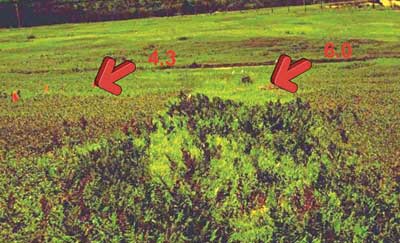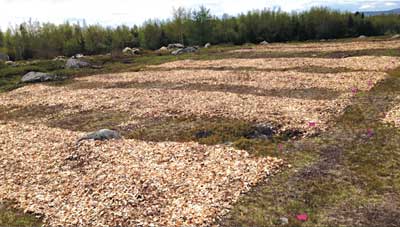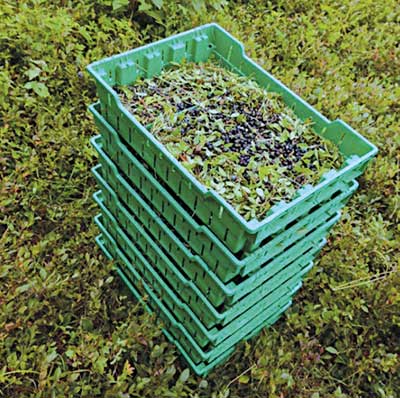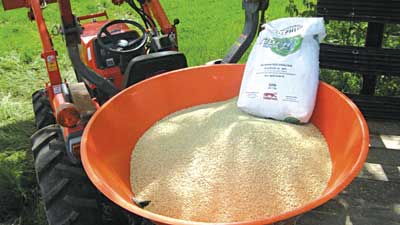 |
| Wild blueberries grow best with a soil pH around 4.0, which also limits nutrient availability for weeds. Photo courtesy of David Yarborough |
 |
| The fertility and mulch trial at Blue Hill Berry Co. Photo by Nicolas Lindholm |
 |
| Harvesters at Blue Hill Berry Co. use green totes that are somewhat smaller, shallower and lighter than the usual blue totes. Photo by Nicolas Lindholm |
 |
| Spreading sulfur at Blue Hill Berry Co. Photo by Nicolas Lindholm |
At MOFGA’s 2017 Farmer to Farmer Conference, David Yarborough, wild blueberry specialist with UMaine Cooperative Extension, and Nicolas Lindholm of MOFGA-certified organic Blue Hill Berry Company discussed factors affecting blueberry yields.
Yarborough said that wild blueberries are unique, with different management from any other crop. They were one of the first plants to become established after the glaciers came through our area. Then the forests grew, and after colonists harvested the forests for ships’ masts, wild blueberries returned to the coast of Maine, New Hampshire and Massachusetts and to the Atlantic provinces and Quebec. They can survive in low-mineral soils because mycorrhizal fungi infect their roots, increasing their reach and breaking down minerals for the plants. Blueberry plants, in return, provide the mycorrhizae with carbohydrates.
Of the two species of lowbush blueberries, the sweet, low species predominates, said Yarborough. The other, called “sourtops,” are slightly taller plants with white, fuzzy stems and poor production. The two species don’t cross pollinate.
Patches are individual plants that grew from one seed. Some are over 100 years old and the size of a football field.
Cultivated (highbush) blueberries selected for productivity can yield 2,400 to 2,800 pounds per acre, while some lowbush clones produce 500 pounds, and others, potentially 20,000 pounds, displaying a wide degree of genetic variability.
Burning, Mowing and Weed Control
The two-year cropping cycle of wild blueberries includes a harvest one year and fallow the next. Native Americans burned the fields – a good practice to help control mummy berry, flea beetles and spanworm, Yarborough continued. Burning also blackens the soil surface so that it warms earlier, stimulating growth. Barrens can be burned because two-thirds of the plant is underground. New sprouts emerge from the root system after burning, producing one vegetative year and one reproductive year. However, burning too hard can reduce the organic pad on the soil.
When possible, most growers flail mow to within an inch of the ground. Mowing is less expensive and has less liability than burning.
In experiments, fields with no bracken fern or dogbane yielded about 5,000 pounds per acre, while those covered with bracken and dogbane yielded about 1,000 pounds per acre. Weeds shade blueberry plants and compete with blueberries for moisture and nutrients, and some weeds attract insect pests that harm blueberries.
Weeds such as St. Johnswort can be cut with a scythe or string trimmer before they go to seed. White birch cut to the base in June, July and August can be eliminated in one season. Willows may require more than three cuts in one year if the plants have been growing for years, but over time cutting will deplete the root system of nutrients.
Placing a 3-inch layer of peat and wood chip mulch on bare areas between fields creates a moist environment where blueberry rhizomes can spread. Sawdust is not used because it dries and blows away.
Soil Fertility
Members of the Ericaceae family, wild blueberries grow best with a soil pH around 4.0, which also limits nutrient availability for weeds. Elemental sulfur can be spread to lower soil pH. To distribute sulfur uniformly, cut the recommended rate in half, said Yarborough, and spread it twice, with 50 percent overlap. Apply it in spring, after frost leaves the ground and before foliage emerges, or in fall, after pruning and before frost. Don’t apply it when plants are wet because it will burn them.
Yarborough said that fertilizers can be applied to nutrient-deficient fields, but fertilizing can also increase weed growth. Nitrogen and phosphorus are the two key nutrients needed. Calcium is good for berry quality. Boron enhances pollination but shouldn’t be too high. Manganese accumulates in the fruit and is good for bone health.
A study initiated in 2004 looked at applying sulfur, mowing versus burning, using three levels of Pro-Holly fertilizer, and cutting weed plants above blueberries with a string trimmer. Mowing plus burning set grasses and broadleaf weeds back, but just mowing resulted in more grasses. Sulfur applications reduced grasses and broadleaf weeds.
Yarborough suggested taking a soil sample at the same time each year – e.g., around July 4 – to determine sulfur needs. Lowering the pH by one unit, e.g., from 5 to 4, will take about 1,000 pounds of elemental sulfur and two to three years, but the effect lasts 10 years beyond that.
In the above study, burned fields yielded more than unburned, and those with sulfur yielded more than those without. Combining burning and sulfur tripled yield over just mowing without sulfur.
“If you can control weeds with burning and sulfur, perhaps you can benefit from fertilizer,” said Yarborough, but “if you don’t control weeds – say [you apply] no sulfur and just mow – you’re not going to get benefits from fertilizer.”
Pests
Remove blueberry maggots during harvest so that they don’t drop to the ground and infest fields again. If possible, keep adjacent fields in the same harvest cycle so that maggots emerging the second year don’t find any fruit. Parasitic wasps do a fairly good job when maggot populations build up, but they are not a consistent control, said Yarborough. A lot of insects emerge from winnow piles, so remove or burn those piles.
Yellow sticky traps can monitor fruit flies, which tend to come from fields harvested the previous year. The middle of the producing field will have few flies, so just the field edges or problem areas might be treated with spinosad (Entrust) or Beauveria bassiana (BotaniGard).
UMaine entomologist Frank Drummond has found that a combination of Mycotrol (a strain of Beauveria) and Entrust controlled flea beetle larvae fairly well over time, said Yarborough.
By not using these broad-spectrum insecticides, however, growers enable predators such as ground beetles, ants, spiders and crickets to populate organic fields. Some wasp parasitoids lay eggs in blueberry maggot flies and blueberry spanworms. Viruses and fungal diseases also help with insect control but may not always be present. In biological control, usually the pest builds up first, then the control builds up and reduces the pest.
Yarborough has seen an increase in mummyberry blight in organic fields, especially unburned fields. Growers can sign up for Extension’s listserve at https://extension.umaine.edu/blueberries/home/wild-blueberry-newsletter-request-form/ and visit its website blog at https://extension.umaine.edu/blueberries/blog/ to track infection periods. Control does not work once to track infection periods. Control does not work once injury appears – eight to 10 days after infection. Those who don’t burn fields may use materials registered as protectants for organic cultivation to avoid mummyberry. Many insects, including ground beetles, eat mummy berries.
Pollination
Fields contain many native bees, which like sandy sites. With just native bees, however, Yarborough said the yield was just 1,200 pounds per acre in one experiment. Bringing in more bumblebees and honeybees improved productivity. The more visits bees make to the flower, the more seeds are produced and thus the larger the fruit. Increased visits also result in more fruit and more even ripening. Conventional growers found that two to three hives per acre result in yields of 5,000 pounds per acre, but using six or so hives per acre did not pay off.
Harvest
Rake and clean berries well, said Yarborough, and treat them gently. Fresh pack lines give a higher return on the fresh market, and the fresh market gives the best return – aside from value-added products.
Walk-behind harvesters, which cost about $10,000, are not good for fresh market berries but are a good alternative to hand raking for the processed market, he said.
Studies have shown that organic systems had lower yields but higher value fruit (25 cents for conventional, $1.40 for organic) and lower input costs, so they could be more profitable than conventional. Detailed information about organic production appears in UMaine Cooperative Extension Publication #304 – Organic Wild Blueberry Production (https://extension.umaine.edu/blueberries/factsheets/organic/).
Five Practices at Blue Hill Berry Company
Lindholm noted the many variables that affect yield, including good and bad years, good and bad fields, productive and nonproductive clones, soil type and drainability, habitat for beneficial insects and pollinators, slope orientation, and proximity to fog banks. He has some very weedy fields that are very productive, and some with hardly a weed that are low producers no matter what he’s done.
He focuses on five practices.
1. Recordkeeping. A folder for each field lists audit trails, sales records, costs, yield, harvest data, etc. – for certification as well as for his use. Online maps help a lot. “I can draw on the NRCS website [map] and get an accurate reading of the area, which helps with [calculating] yield per acre,” said Lindholm. He adapted an enterprise budget from UMaine Cooperative Extension for each of his fields. He can calculate pounds per acre, dollars per pound and net income for a particular field and year.
2. Regular pruning. Sticking to a regular two-year cycle for an entire field helps break insect, disease and weed cycles. Lindholm mows fields that can be mowed with a Mott hammer-knife mower, a three-point hitch implement. For fields that can’t be mowed and are burned, he got a Maine Blueberry Equipment straw spreader from Uncle Henry’s and can now spread straw evenly and faster. Burning takes three people, who burn the perimeter first and set 5-gallon buckets of water every 200 feet or so around the perimeter. They use a diesel and kerosene mix. He doesn’t burn fields that aren’t productive enough; mowing is cheaper.
3. Strict pH control. Lindholm aims for a soil pH of 4.0. North Country Organics delivers sulfur to a local landscaping store in Blue Hill, and the store loads the pallet onto Lindholm’s truck. He spreads the material with a cyclone spreader. Sulfur is very expensive but very effective for weed control.
4. Scheduled weed control in June, July and early September. Ratchet and anvil loppers cut 1- to 2-inch saplings. Larger material is cut with a bush hog or a brush blade on a weed whacker (which cuts through wisps of saplings easily). A Japanese root cutting tool rips out entire crowns of thinly rooted, crown-type plants such as goldenrod. Lindholm just got a long-handled “old blueberry tool” from the dump. The tool he uses most is a weed whacker with heavy-duty twine.
5. Pollination. Lindholm uses about one hive per acre and has noticed a huge difference in the quality of various hives. Another grower said he uses two honeybee hives per acre and one bumblebee hive for 1.3 acres. Lindholm rents hives from Lincoln Sennett of Swan’s Honey in Albion, getting the hives at night and putting them out early in the morning. Electric fencing with a big charger protects hives from bears.
Lindholm has a walk-behind harvester, which produces sufficient quality for fresh sales, but most of his crop is hand raked and handled carefully by 10 to 15 employees – many returnees – each summer. They use green totes that are a little smaller, lighter and shallower than the blue, thicker totes. Trays are moved to the shade or the winnowing shed quickly.
Fertility and Mulch Trial
Lindholm also discussed results of his four-year SARE (USDA Sustainable Agriculture Research and Education) grant.
“Typically organic fields are too weedy to allow a farmer to fertilize, as the weeds outcompete the blueberry plants,” said Lindholm. His study tried to find a way to use hardwood sapling “weeds” from blueberry fields as a source for mulch to smother weeds, improve soil quality and allow select fertilizer applications. Over two harvest-prune cycles (four years), he used soil and foliar tests and refractometer readings to study connections among weed suppression, fertilizing and crop nutrition.
In the spring of 2014, with a chipper on the back of his truck, he made ramial chips – chips of hardwood branches smaller than 3 inches in diameter with no leaves – from birch and other brush growing in his blueberry fields. Ramial wood chips have a higher cambium to cellulose ratio, Lindholm explained, hence a C:N ratio close to the 30:1 ideal. “That combination promotes better humification, soil building and soil fungi,” he said.
He established 16 12- by 50-foot plots with a 4-foot alley between each, all in one field of about 5 acres so that plots had a similar field history. Four treatments were replicated four times randomly:
• ramial chip mulch with half-rate fertilizer application (35 pounds per acre of N from fish meal and 75 pounds per acre of Ca from aragonite)
• just ramial chip mulch
• control (no mulch or fertilizer)
• mulch plus full-rate fertilizer (70 pounds of N and 150 pounds of Ca).
Lindholm spread the fertilizer and then 2 to 4 inches of mulch, where applicable, by hand.
By fall of 2014, blueberry plants were emerging through the thick mulch but were inhibited by it through the following summer.
In 2015 Lindholm put honeybees on the field and had a crop. He harvested, winnowed and weighed berries from each plot individually and took refractometer readings. Chips interfered with raking, harvesting and winnowing in 2015.
Mulch gave little weed suppression in 2015 and had not broken down at all. Still, the crop was good overall, averaging 2,500 pounds per acre of sellable grade A berries over all the plots.
In April 2016 he burned the field, after which the mulch was still very present – some of it smoldering a little.
By early July 2016 the plants exhibited strong growth and weeds were suppressed well in the full-rate fertilizer and mulched plots, partly due to burning and weed whacking above the plants. So mulch helped control weeds and, on hot, sunny days, regulate soil temperature and moisture for a more consistent, healthful soil environment.
In the spring of 2017, plants were healthy and blooming well. Much of the mulch had started to settle but was still present, and weeds were not outcompeting blueberry plants. In early August Lindholm again harvested, winnowed and weighed each plot separately and took refractometer readings. The 2017 crop was lighter due to drought, averaging about 1,600 pounds per acre across all plots.
Mean yields of grade A salable berries were:
| Treatment | Lbs./A equivalent | Lbs./A equivalent |
| 2015 | 2017 | |
| Control | 2,717 | 1,639 |
| Mulch-only | 2,461 | 1,492 |
| Mulch + 1/2-rate fertilizer | 2,362 | 1,557 |
| Mulch + full-rate fertilizer | 2,312 | 1,680 |
Lindholm took foliar samples from each plot in early July 2016 to compare with baseline data from 2010 of the same field. Plants from plots with full fertilizer and mulch almost always had higher nutrient numbers, except for potassium, which was within recommended levels.
Higher Brix readings (a measure of the percentage of sugars) are generally thought to indicate healthier plants, especially with vegetables and berries, since plants use sugars for growth. Because Brix readings depend on conditions during sampling (e.g., time of day, temperature, etc.), Lindholm did all of his readings at one time. Curiously, Lindholm noted that the lowest Brix reading corresponded with the highest yields (from control plots in 2015 and full-rate fertilizer plus mulch plots in 2017) – the opposite of what he expected – but the mean of the two harvest years showed little difference in readings. He concluded that lower Brix levels can indicate higher yields in wild blueberries.
Lindholm took two soil samples from each plot and sent one to UMaine (which measures total nutrients in the soil) and one to Perry Agricultural Laboratory (PAL) in Missouri (which extracts nutrients with the Reams process for a better picture of nutrient availability for plants, and checks both ammonia and nitrate N). Readings from the two labs differed but were relatively similar from plot to plot.
Soil pH dropped from 4.9 (the baseline measurement from 2010, after which Lindholm applied sulfur) to 4.4 in the full fertilizer/mulch plots, 4.2 in the control and half-fertilizer/mulch plots, and 4.0 in the mulch-only plots, based on UMaine test results. PAL results were lower (3.5 to 3.8) but relatively similar.
The percent organic matter in 2016 was lowest in plots receiving the full rate of fertilizer but was still very high (20 percent) there.
(Data from soil and tissue sampling, from Brix readings and yield are presented at https://projects.sare.org/project-reports/fne14-808/).
The general conclusion, said Lindholm, is that the mulch only and the mulch plus half-rate fertilizer treatments did not effectively raise nutrient levels or yields over the four-year study, so are not recommended. Some gains occurred in foliar and soil nutrient levels from use of ramial chip mulch plus the full-rate organic fertilizer applications, and this treatment resulted in increased yields in the second (2017) harvest after application. Despite yield gains with mulch plus full-rate fertilizer, however, the costs of this treatment may outweigh the gains in revenue after two harvests. The cost was about $6,000 per acre – almost $4,000 of that for labor, and much of that labor was to make ramial chips. The cost minus labor was $1,600 per acre.
Even though his SARE funding has run out, Lindholm plans to measure the third (2019) harvest to see whether increased revenues from increased yields are profitable.
